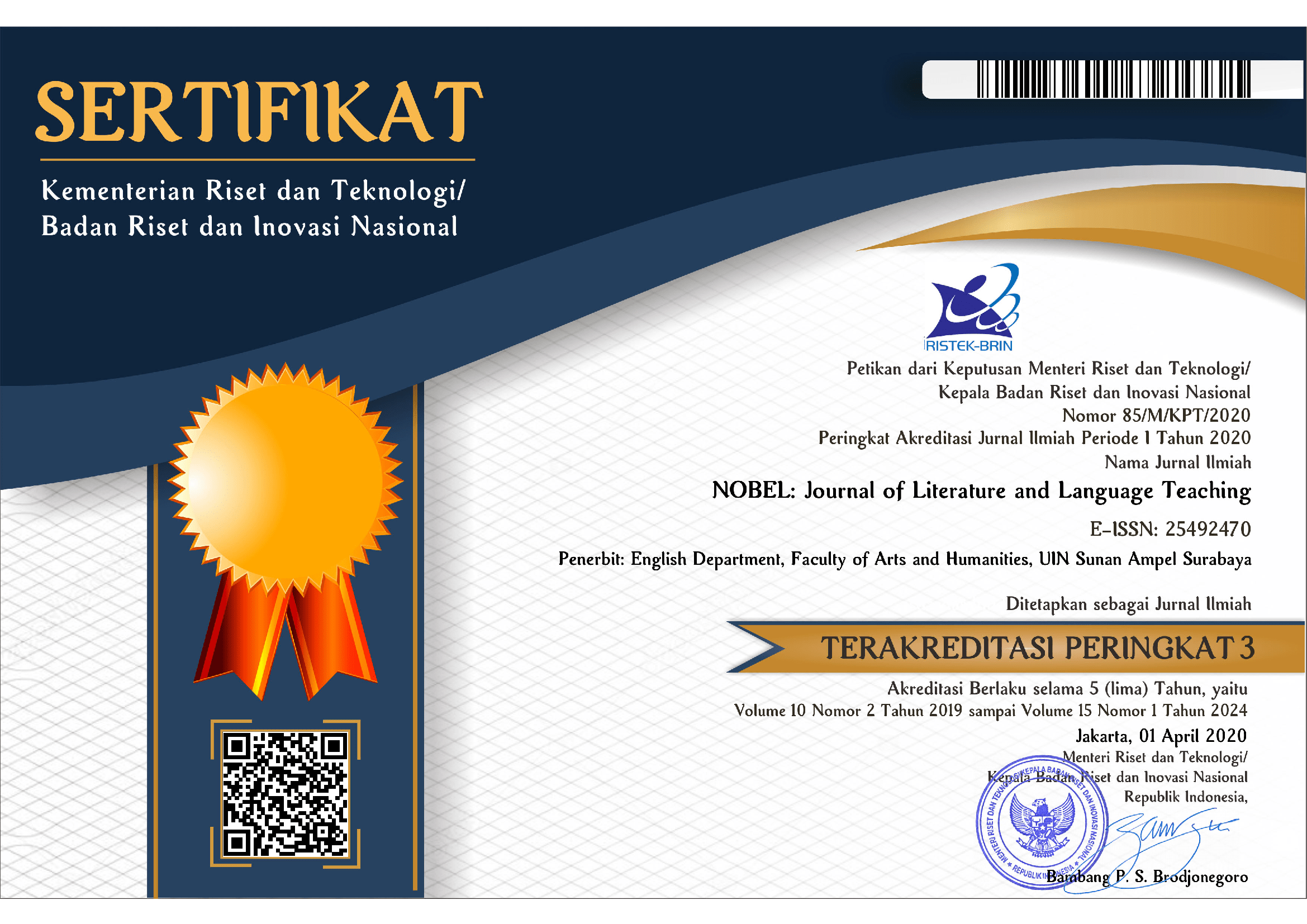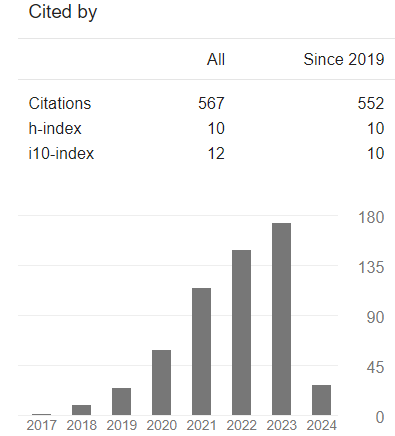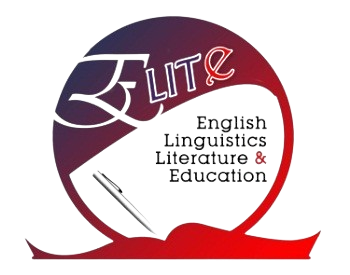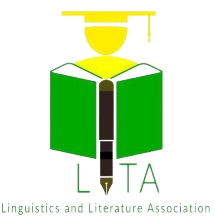Ecological Environmentalism in Geg Ary Suharsani's Kunang-Kunang Hitam
DOI:
https://doi.org/10.15642/NOBEL.2023.14.2.149-163Keywords:
ecofeminism, environmentalism, Kunang-Kunang Hitam, TamblinganAbstract
The Tamblingan land conflict is closely related to the investment trend heading towards Bali’s upstream area. Investors are converting Tamblingan forest land into hotels and tourism to reap the benefits of nature tourism in the most natural forest. This issue is discussed in the novel Kunang-Kunang Hitam by Geg Ary Suharsani. This paper aims to describe the struggle of the female character Ni Luh Candri in the Tamblingan land conflict as narrated in the novel Kunang-Kunang Hitam (KKH). This study uses a Susan Griffin perspective ecofeminism approach. The results of this study indicate that the struggle of the female character Ni Luh Candri in defending the Tamblingan forest is divided into two forms: Ni Luh Candri’s struggles related to nature, such as refusing land conversion, protecting rare plants, symbolic communication to fireflies and Ni Luh Candri’s struggles related to nature humanistic environment, such as becoming Leak, burning incense, displaying rangda mask, and advocating for communities around the forest. This research proves that women can take various important actions (ecological environmentalism) to preserve the environment.
Downloads
References
Agung, A., Agung, G., & Suprina, R. (2020). BALI – A Traditional Society in Transformation. Journal of Culture, Society and Development, 59, 14–18. https://doi.org/10.7176/jcsd/59-03
Andrews, D., Smith, K., & Morena, M. A. (2019). Enraged: Women and Nature. Women Power Food Struggles, 11, 6–15.
Ardhana, I. K. (2019). Pengliakan Dalam Kajian Filsafat, Agama, Dan Ilmu Pada Masyarakat Bali. Mitos, Magic, Dan Pengliakan: Kisah Tradisi Pengiwa Pada Calonarang Di Jawa Dan Bali, 1–120. repo.unhi.ac.id/bitstream
Bali, K. (2020). Lestarikan Bali, Kawasan Hutan di Danau Tamblingan Diperjuangkan Jadi Hutan Adat. Kanal Bali. https://kumparan.com/kanalbali/lestarikan-bali-kawasan-hutan-di-danau-tamblingan-diperjuangkan-jadi-hutan-adat-1uj54XDjXNk/full
Cantrell, C. H. (1994). Women and Language in Susan Griffin’s Woman and Nature: The Roaring Inside Her. Hypatia, 9(3), 225–238. https://doi.org/10.1111/j.1527-2001.1994.tb00459.x
Coste, M. (2022). Le jeu de la parodie dans Woman and Nature: The Roaring Inside Her de Susan Griffin. Itinéraires, 2021–1, 0–15. https://doi.org/10.4000/itineraires.10293
Eyong, K. A., Ngwa, C. A., & Talla, R. T. (2020). Traditional Land Conflict Resolution Strategies in the Banyang Country , Cameroon from Pre-colonial Time to Present. 39–47.
Farida, D. N. (2017). Kritik ekologi Sastra Puisi Perempuan Lereng Gunung Karya Ika Permata Hati Dalam Antologi Puisi Perempuan Di Ujung Senja Melalui Ekofeminisme Susan Griffin. Basindo, 1(2), 48–52. https://doi.org/http://dx.doi.org/10.17977/um007v1i22017p048
Foster, E. (2021). Ecofeminism revisited: critical insights on contemporary environmental governance. Feminist Theory, 22(2), 190–205. https://doi.org/10.1177/1464700120988639
Griffin, S. (1978). Women and Nature: The Roaring Inside Her. Harper & Row.
Griffin, S. (1990). ‘Curves Along the Road’. In: Irene Diamond and Gloria Feman Orenstein (Reweaving). CA: Sierra Book Club.
Griffin, S. (2016). Woman and Nature: The Roaring Inside Her.
Indra Wirawan, K. (2019). Liturgi Sakralisasi Barong-Rangda: Eksplorasi Teo-Filosofis Estetik Mistik Bali. Mudra Jurnal Seni Budaya, 34(3), 417–427. https://doi.org/10.31091/mudra.v34i3.800
Kapela, I. M. A. (2020). Tamblingan to be A Spiritual Tourism Destination. Bali Tourism Journal, 4(2), 31–34. https://doi.org/10.36675/btj.v4i2.45
Kaur, G. (2019). Eco feminism in the Context of Modernization in Indian Perspective : A Review. Journal of Critical Reviews, 6(02), 20–23. http://www.jcreview.com/admin/Uploads/Files/621ec05561c831.80293036
Leiwakabessy, J. E. M., Kasnawi, T., & Agustang, A. (2021). The reality of the conflict of customary lands between the land of laha and the air force in ambon city (case study customary land in the land of laha). Turkish Online Journal of Qualitative Inquiry (TOJQI), 12(9), 4797–4804.
Maulana, R., & Supriatna, N. (2019). Ekofeminisme: Perempuan, Alam, Perlawanan atas Kuasa Patriarki dan Pembangunan Dunia (Wangari Maathai dan Green Belt Movement 1990-2004). FACTUM: Jurnal Sejarah Dan Pendidikan Sejarah, 8(2), 261–276. https://doi.org/10.17509/factum.v8i2.22156
Medan, K. K., & Kase, D. A. (2020). Of the Cross Country Community Land Conflict: the Case of Indonesia and Timor Leste Traditional Law Implementation. International Seminar on …, 565–588. https://www.conference.undana.ac.id/ISSDCBA/article/download/135/114
Merchant, C. (2020). Earthcare: Women and the Environment. Environment, 62(3), 17–27. https://doi.org/10.1080/00139157.2020.1750918
Mir, S., Aslam, S. Bin, & Aslam. (2021). Exploitation of Women and Land: An Ecofeminist Study of Noor by Sorraya Khan. Pakistan Languages and Humanities Review, 5(II), 27–37. https://doi.org/10.47205/plhr.2021(5-ii)1.3
Nanda, J. K. (2022). The Theory of Ecofeminism vis-a-vis Marganet Atwood’s Surfacing. Journal for Research Scholar and Professionals of English Languange Teaching, 6(31), 1–12. https://doi.org/https://doi.org/10.54850/jrspelt.6.31.005
Navgire, P. E. (2021). A Study of Ecofeminism in A River Sutra by Gita Mehta. Research Journal Of English (RJOE), 3(2), 101–112. https://www.rjoe.org.in/Files/v6i3/27.RJOE-D.Kiruthiga(185-193) (2).pdf
Nawaz, A., Iftikhar, N., & Maqbool, R. (2021). Woman-Nature affinity in Desai’s Where Shall We Go This Summer: An Ecofeminist Analysis. Global Language Review, VI(I), 248–253. https://doi.org/10.31703/glr.2021(vi-i).27
Noviana, F., Mulyadi, B., & Rahmah, Y. (2021). Ecofeminism Perspective on the Role of Women Concerning Nature in Miyori No Mori Anime. ICENIS, 02001. https://doi.org/https://doi.org/10.1051/e3sconf
Pemunta, V. N., Ngo, V. N., & Comber, R. Y. (2020). Women ’ s housing , land and property rights : a recipe for political instability in post-conflict Burundi ? Ngambouk Vitalis Pemunta * Ngo Valery Ngo Rosaline Yumumkah Cumber. Gender Studies in Developing Societies, 3(4), 327–360.
Rahayu, M. (2009). Literature in language teaching. LiNGUA: Jurnal Ilmu Bahasa dan Sastra, 4(1).
Rahayu, M. (2020). Environmental literacy discourse represented in local portal “nggalek.co.” IOP Conference Series: Earth and Environmental Science, 456(1). https://doi.org/10.1088/1755-1315/456/1/012064
Rahayu, M. (2021, January). Symbolic Violence Represented in Royyan Julian’s Bulan Merah Rabu Wekasan. In Fifth International Conference on Language, Literature, Culture, and Education (ICOLLITE 2021) (pp. 466-470). Atlantis Press.
Rigby, K. (2018). Women and Nature Revisited: Ecofeminist Reconfigurations of an Old Association. Palgrave Macmillan.
Saputra, AW., Tjahjono, T. (2021) Trajektori Perempuan dalam Novel mentari Nur Syamsiah Bersinar. Jurnal Pembelajaran Sastra 3 (1), 45-60
Saville, A., & Adams, A. (2020). Trust and Discourse: A Case of Land-Use Conflict in Alachua County, Florida. Journal of Rural Social Sciences, 35(1), 5. https://egrove.olemiss.edu/cgi/viewcontent.cgi?article=1016&context=jrss
Suharsani, G. A. (2020). Kunang-Kunang Hitam. Binsar Hiras.
Suka, I. G. (2012). Teori Etika Lingkungan. Udayana University Press.
Suriyani, L. De. (2021). Kawasan Bedugul: Ketika Catur Desa Adat Ingin Kelola Hutan di Hulu Bali. Mongabai: Situs Berita Lingkungan. https://www.mongabay.co.id/2021/03/09/kawasan-bedugul-ketika-catur-desa-adat-ingin-kelola-hutan-di-hulu-bali-bagian-1/
Wafa, A. (2020). Leak Sebagai Ajaran Mistisme Hindu Bali. Universitas Islam Negeri Sunan Kalijaga Yogyakarta, 1–172.
Downloads
Published
How to Cite
Issue
Section
License
Copyright (c) 2023 NOBEL: Journal of Literature and Language Teaching

This work is licensed under a Creative Commons Attribution 4.0 International License.







